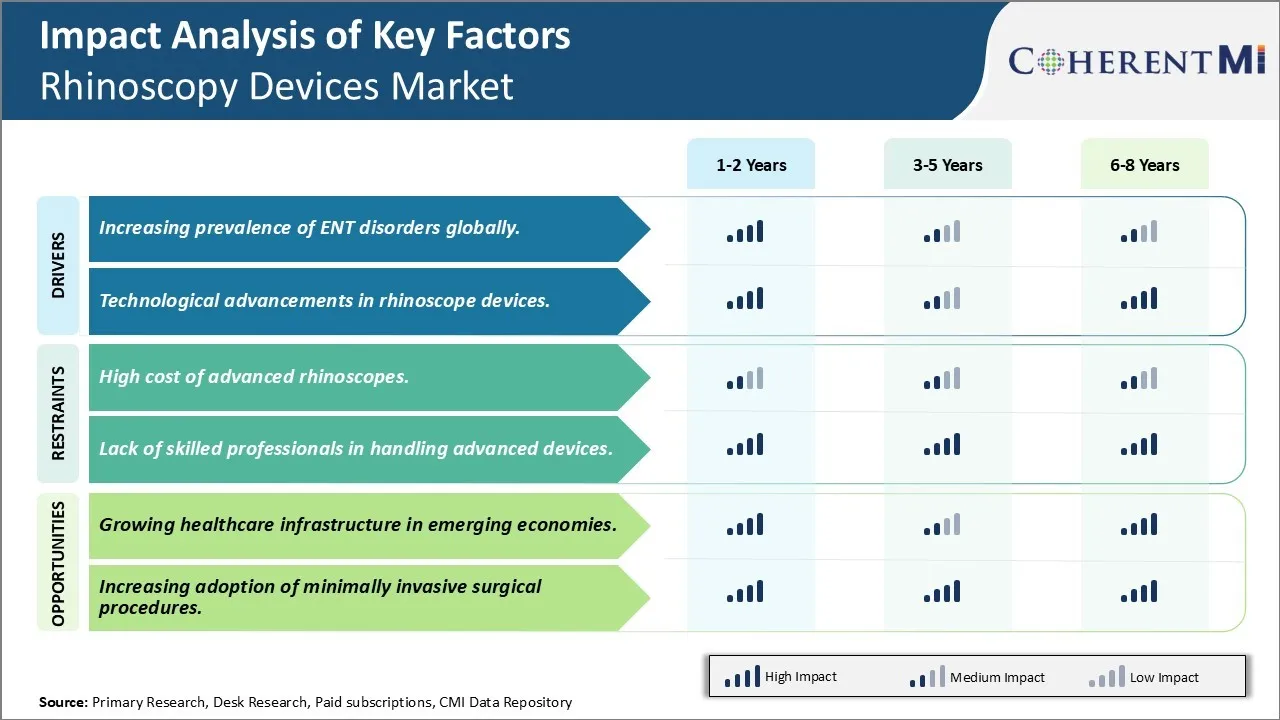Rhinoscopy Devices Market Trends
Market Driver - Increasing Prevalence of ENT Disorders Globally Drives the Demand for Medical Devices.
With rapid urbanization and changes in lifestyle, the prevalence of ENT disorders has been increasing steadily across the world. ENT disorders such as sinusitis, nasal polyps, deviated nasal septum and chronic rhinitis are becoming more common due to factors like air pollution, second hand smoking, indoor air quality and work-related issues. These disorders affect the airways passages in the nose, throat, and ears which can cause inflammation, blockage and swelling. Prolonged inflammation further increases the risk of more serious complications like chronic rhinosinusitis. According to WHO estimates, over one billion people suffer from chronic rhinosinusitis globally with direct and indirect costs amounting to billions of dollars every year.
Rising environmental pollution levels have had a significant impact on increasing ENT issues, especially in developing nations. Factors like poor air quality in cities due to increased vehicular emissions and industrial pollution expose people to various allergens and pollutants on a daily basis. Second hand smoking that exposed non-smokers to tobacco smoke is another key reason. Work environments with exposure to dust, gases and fumes are also common in certain professions and increase the chances of nasal and throat inflammation over time. Changing lifestyles with reduced physical activity and time spent indoors have worsened indoor air quality levels as well. Poor ventilation and use of chemicals/fragrances can irritate the nasal passages. With greater urbanization, more people now live and work in close proximity which facilitates easier transmission of viral and bacterial infections affecting the ENT region. All these changes have led to a rise in underlying chronic conditions causing nasal blockage, nasal polyps and sinus problems.
The rising incidence of ENT disorders has resulted in greater demand for diagnostic and treatment options. Rhinoscopy using a thin, flexible tube allows examination of the nasal cavity and sinuses to detect abnormalities. Its minimally invasive nature and ability to obtain clearer views inside makes it preferable compared to other imaging modalities. More rhinoscopy procedures will need to be performed to accurately diagnose and treat the growing patient base suffering from ENT issues worldwide. This increasing prevalence of conditions affecting the ears, nose and throat therefore acts as a key driver for the global rhinoscopy devices market.
Market Driver - Technological Advancements in Rhinoscope Devices Encourages Market Demand in the Forecast Period.
Rhinoscopy technology has advanced significantly over the past decade with vendors incorporating newer innovations to improve functionality, image quality and ease of use. Early rigid rhinoscopes made of stainless steel provided limited angled views and discomfort to patients. Introduction of small diameter, flexible fiber optic bundles in modern digital rhinoscopy systems have enabled greater maneuverability and access to posterior nasal areas easily. Advances in digital imaging sensors and chip technology have enhanced resolution of captured images providing ENT specialists with sharper, high-definition views of nasal passages on computer monitors in real time. This assists in more accurate detection of anatomical variations, polyps, tumors and infections.
Integration of complementary technologies like xenon light sources and video cameras have enabled full video recording and documentation of procedures. Clinicians can capture still images and video clips during rhinoscopy for record keeping, consultation with other physicians and to demonstrate abnormalities to patients clearly. Incorporation of charge coupled devices (CCDs) instead of complementary metal-oxide semiconductor (CMOS) image sensors improved noise performance and image clarity further. Touchscreen control panels with intuitive graphical user interfaces are easier to use for novice physicians compared to conventional joystick controls. Some latest models offer 3D and zoom capabilities also.
continuous research and development in miniaturization and digital signal processing have led to availability of ultra-slim video rhinolaryngoscopes less than 3mm in diameter now. These provide maximum maneuverability even in pediatric patients and reduce patient discomfort.

Market Challenge - High cost of Advanced Rhinoscopes Creates Further Obstacles.
One of the major challenges the rhinoscopy devices market faces is the high cost of advanced rhinoscopes. Rhinoscopy procedures require flexible or rigid endoscopes with high-quality lenses and imaging sensors to provide detailed views of the nasal cavity and sinuses. However, manufacturing such sophisticated endoscopy equipment involves substantial research and development investments. This translates to significantly high prices of technologically advanced rhinoscopes ranging anywhere between USD 50,000 to USD 150,000. The high equipment costs pose a considerable barrier, especially for small practices and clinics in developing regions to adopt the latest rhinoscopic systems. While hybrid and digital rhinoscopes do offer superior visualization capabilities compared to traditional analog scopes, their luxury price point remains unaffordable for many healthcare facilities. This challenges wider uptake of advanced tools and hinders physicians from performing detailed diagnosis. Unless manufacturers find ways to make state-of-the-art rhinoscopy technology more cost-effective, the issue of steep capital costs will continue restricting the market's overall growth trajectory.
Market Opportunity- Growing Healthcare Infrastructure in Emerging Economies Drives Further Opportunities.
One major opportunity for the rhinoscopy devices market is the growing healthcare infrastructure in emerging economies. Rapid urbanization and economic development in Asia Pacific and Latin America have boosted healthcare spending across developing nations over the past decade. Countries such as China, India, Brazil, and others are witnessing substantial government investments to strengthen their medical infrastructure including setting up new hospitals and clinics. This expanding network of healthcare facilities is generating rising demand for medical devices and equipment. More treatment centers are adopting minimally invasive endoscopic procedures as the preferred choice for sinonasal diagnoses and surgeries. The swelling patient pool and improving access to quality care present lucrative sales opportunities for rhinoscopy device manufacturers. To capitalize on this prospect, companies must focus on launching more affordable product lines tailored for price-sensitive emerging markets. Offering localized aftersales support can also help them earn greater shares in high-growth developing countries.